
|
Your guide to recently released books, CDs and other teaching resources. For additional reviews of French-language resources, visit Lu, vu, entendu. With the exception of some classroom sets, items reviewed are available on loan from the Margaret Wilson Library at the College. Contact Olivia Hamilton at 416-961-8800 (toll-free in Ontario 1-888-534-2222), ext 679, or e-mail library@oct.ca. |
Guides and disasters
What Successful Mentors Do
81 Research-Based Strategies for New Teacher Induction, Training, and Support
by C.D. Hicks, N.A. Glasgow and S.J. McNary
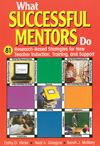 Mentoring
has always existed in schools but is receiving renewed attention in research
literature as new paradigms of schools as "learning organizations" emerge.
What and how teachers know, and what constitutes professional development
continue to be contested issues.
Mentoring
has always existed in schools but is receiving renewed attention in research
literature as new paradigms of schools as "learning organizations" emerge.
What and how teachers know, and what constitutes professional development
continue to be contested issues.
What Successful Mentors Do provides 81 strategies to smooth teachers' transition into the profession. Issues such as student-teacher interaction, classroom management, managing curriculum, evaluation and teaching at-risk students, to name a few, have been identified in traditional research literature as problematic for new teachers. This book connects these concerns to particular research studies, discusses possible applications and notes possible pitfalls for each. But these concerns are part of the complex social and moral matrix where teachers work and learn.
This ambitious book might be helpful to those who understand mentoring as an application of research-based strategies, but it does not address the dialectical processes at the heart of mentoring in any great depth. It is not for those who wish to deepen their understanding of mentoring but for those who wish an overview of traditional concerns.
![]() What Successful
Mentors Do, Corwin Press, Thousand Oaks, California, 2004, ISBN
0-7619-8887-4, softcover, 224 pages, US$29.95, 805-499-0721, fax 805-499-0871, www.CorwinPress.com
What Successful
Mentors Do, Corwin Press, Thousand Oaks, California, 2004, ISBN
0-7619-8887-4, softcover, 224 pages, US$29.95, 805-499-0721, fax 805-499-0871, www.CorwinPress.com
Reviewed by Gianna Di Rezze, a teacher-researcher, is currently mentoring a teacher new to special education in the Toronto Catholic DSB.
Discovering Gifts in Middle School
Learning in a Caring Culture Called Tribes
by Jeanne Gibbs
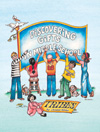 The
Golden Rule – treat others as you would like to be treated – is the central
dictum in Tribes, Jeanne Gibbs's trademark approach to learning communities.
The program's idea is that to achieve responsive, student-centered, active
learning, we must first create an inclusive and caring culture. Gibbs
borrows from Ojibwe, Navajo and Hopi ideals in group interaction. Twelve
values are taught in Tribes but four community agreements or rules are
the most critical:
The
Golden Rule – treat others as you would like to be treated – is the central
dictum in Tribes, Jeanne Gibbs's trademark approach to learning communities.
The program's idea is that to achieve responsive, student-centered, active
learning, we must first create an inclusive and caring culture. Gibbs
borrows from Ojibwe, Navajo and Hopi ideals in group interaction. Twelve
values are taught in Tribes but four community agreements or rules are
the most critical:
- Attentive Listening
- Appreciation / No Put-downs
- The Right to Pass
- Mutual Respect
A large part of Gibbs's book, and I think the most valuable, is the 147 pages of learning strategies and activities. These are truly unique and creative ideas for the classroom. I wish I'd had them years ago for my language-arts classes. They provide practical and graceful ways to work as a respectful, nurturing community.
![]() Discovering
Gifts in Middle School, CenterSource Systems, Windsor, California,
2001, ISBN 0-932762-50-6, 446 pages, US$32.95, tel 707-838-1061, fax
707-838-1062, www.tribes.com, tribes@tribes.com
Discovering
Gifts in Middle School, CenterSource Systems, Windsor, California,
2001, ISBN 0-932762-50-6, 446 pages, US$32.95, tel 707-838-1061, fax
707-838-1062, www.tribes.com, tribes@tribes.com
Reviewed by Kara Smith, an English Language Arts teacher with the Faculty of Education, University of Windsor and the Lambton-Kent Board of Education.
The Virtues Project Educator's Guide
Simple Ways to Create a Culture of Character
by Linda Kavelin Popov
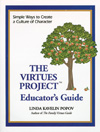 Tribes
originated in California but its foundation – the encouragement of mutual
respect – reminds me of Linda Kavelin Popov's work in British Columbia
in the early 1990s: The Virtues Project. A new edition of Virtues shows
how to recognize each child's innate qualities of character. Fifty-two
virtues drawn from seven faiths – Bahá'i, Buddhism, Christianity,
Hinduism, Islam, Judaism and Zoroastrianism – are listed alphabetically,
from assertiveness to unity.
Tribes
originated in California but its foundation – the encouragement of mutual
respect – reminds me of Linda Kavelin Popov's work in British Columbia
in the early 1990s: The Virtues Project. A new edition of Virtues shows
how to recognize each child's innate qualities of character. Fifty-two
virtues drawn from seven faiths – Bahá'i, Buddhism, Christianity,
Hinduism, Islam, Judaism and Zoroastrianism – are listed alphabetically,
from assertiveness to unity.
This program claims to move from shaming to naming by recognizing behavioural problems as teachable moments. Like Gibbs, Popov believes in a focus on positive virtues rather than judgements. One of the many exemplary teachers in the book says, "With harsh discipline you learn systematic mediocrity, so that you won't be noticed . shaming children discourages excellence."
The book provides a superb overview as well as practical examples of how to spot virtue and activities for educators.
![]() The Virtues
Project Educator's Guide, Jalmar Press, Carson, California, 2000,
ISBN 188039684X, softcover, 246 pages, US$31.00, tel 1-888-261-5611,
fax 1-423-870-4774, www.virtuesproject.com
The Virtues
Project Educator's Guide, Jalmar Press, Carson, California, 2000,
ISBN 188039684X, softcover, 246 pages, US$31.00, tel 1-888-261-5611,
fax 1-423-870-4774, www.virtuesproject.com
Reviewed by Kara Smith , an English Language Arts teacher with the Faculty of Education, University of Windsor and the Lambton-Kent Board of Education.
Caprices et petits bobos
by Louis Cartier and Chantale Métivier
(in French only)
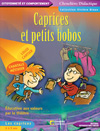 Caprices
et petits bobos, designed for six- to nine-year-old students, consists
of five short stories about values. Although written in Québec
for students whose first language is French, the work is easily adapted
for Primary French Immersion students.
Caprices
et petits bobos, designed for six- to nine-year-old students, consists
of five short stories about values. Although written in Québec
for students whose first language is French, the work is easily adapted
for Primary French Immersion students.
Stories of children's everyday lives are presented in clear, short sentences in small reproducible booklets. Stories address distinctions between responsible and irresponsible, for example, or between privileges and rights.
The students' book begins with activities, which assume an understanding of the stories. Students can enhance vocabulary while taking on various characters' roles to understand the story from different perspectives.
The teachers' book includes advice on how to use this resource with students who can read and those who cannot. There are even ideas for incorporating mathematics, arts and French lessons. Drama activities are well developed and will be useful even for teachers who have little experience.
And it's in French! I recommend it for any French-language or immersion school.
![]() Caprices et
petits bobos, Chenelière Éducation, Montréal,
2005, ISBN 2-7650-0774-8, softcover, 108 pages, $32.95, tel 514-273-1066,
fax 514-276-0324 or 1-800-814-0324, info@cheneliere-education.ca, www.cheneliere-education.ca.
Caprices et
petits bobos, Chenelière Éducation, Montréal,
2005, ISBN 2-7650-0774-8, softcover, 108 pages, $32.95, tel 514-273-1066,
fax 514-276-0324 or 1-800-814-0324, info@cheneliere-education.ca, www.cheneliere-education.ca.
Reviewed by Ramona Dempsey , currently on maternity leave, who will teach Grade 1 French Immersion this March at Louis-Honoré Fréchette de Vaughan PS, York Region DSB.
Space Trekkers (DVD)
Way Cool Science set of 4 DVDs (also on VHS)
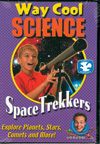 Here's
your chance to use the DVD side of the combo player in your school. Space
Trekkers is one title in the Way Cool Science set of DVDs. Others
are Stormchasers, Rockfinders and Biotrackers.
Here's
your chance to use the DVD side of the combo player in your school. Space
Trekkers is one title in the Way Cool Science set of DVDs. Others
are Stormchasers, Rockfinders and Biotrackers.
Space Trekkers is recommended for ages five and up and seems to fit best with Ontario's Grade 6 science and technology curriculum. The trek is a simulated voyage to survey the sun, moon and nine planets. Three quiz-show segments review the facts. However, there will be a few concerns.
The greatest concern is accuracy. According to one DVD, "There are times when a planet is closer to the sun than others. That's what causes the four seasons here on earth." This is just plain wrong. The axial tilt of the earth is the cause of the seasons.
In addition, units used are miles and degrees Fahrenheit. And while there are some beautiful pictures and graphics, host Max Orbit plays it over the top – in a Jim Carey, elastic-faced, over-expressive manner. Beakman and Bill Nye the Science Guy can pull this off with the support of great writers, good sets, costumes and big production budgets, but Space Trekkers doesn't hit the mark. Not all Grade 6 students will buy into this style of presentation.
The best use of this resource in Ontario classrooms would be as a source of good pictures. Turn down the volume, use the fast-forward button and refer to your own planetary fact sheet that uses kilometers for distance and Celsius for degrees. You may not be Bill Nye but you can do better than this.
![]() Space Trekkers,
Way Cool Science Set (4 titles), Big Kids Productions, Austin, Texas,
2003, DVD & VHS, each 30 min, US$14.95, set US$49.95, tel 1-800-477-7811,
fax 512-441-0339, www.bigkidsvideo.com, customerservice@bigkids.com
Space Trekkers,
Way Cool Science Set (4 titles), Big Kids Productions, Austin, Texas,
2003, DVD & VHS, each 30 min, US$14.95, set US$49.95, tel 1-800-477-7811,
fax 512-441-0339, www.bigkidsvideo.com, customerservice@bigkids.com
Reviewed by Steve Kennedy, a science and math teacher at Sir Winston Secondary School in Hamilton.
Mom and Mum Are Getting Married
by Ken Setterington, Illustrated by Alice Priestley
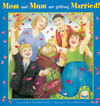 This
book is a simple yet powerful treatment of the socially contentious issue,
same-sex marriage. Rosie – an engaging and determined little problem
solver – is to be a flower girl at her mom's wedding. Things specific
to same-sex families as well as the usual wedding-planning issues – size,
location, formal versus informal – are presented.
This
book is a simple yet powerful treatment of the socially contentious issue,
same-sex marriage. Rosie – an engaging and determined little problem
solver – is to be a flower girl at her mom's wedding. Things specific
to same-sex families as well as the usual wedding-planning issues – size,
location, formal versus informal – are presented.
Although aimed at ages eight and under, older students (Junior and Intermediate) may better understand the book. Even at that, it will require support from the teacher. I would recommend it for reading on the themes of family, sharing, love and acceptance, and as a way of making classrooms more inclusive.
![]() Mom and Mum
Are Getting Married, Second Story Press, Toronto, 2004, ISBN 1-896764-84-3,
hardcover, 24 pages, $14.96, distributed by University of Toronto Press,
tel 416-667-7791 or 1-800-565-9523, fax 416-667-7832 or 1-800-221-9985, utp@utoronto.ca
Mom and Mum
Are Getting Married, Second Story Press, Toronto, 2004, ISBN 1-896764-84-3,
hardcover, 24 pages, $14.96, distributed by University of Toronto Press,
tel 416-667-7791 or 1-800-565-9523, fax 416-667-7832 or 1-800-221-9985, utp@utoronto.ca
Reviewed by Anjana Thom, an early literacy teacher, in collaboration with Mary Samuel, a staff development officer. Both are with the Peel District School Board.
The Kids Book of the Night Sky
by Jane Drake and Ann Love, Illustrated by Heather Collins
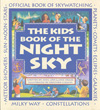 With
this book, written by sisters Ann Love and Jane Drake, anyone living
in the northern hemisphere can become an informed night-sky watcher for
365 days of the year.
With
this book, written by sisters Ann Love and Jane Drake, anyone living
in the northern hemisphere can become an informed night-sky watcher for
365 days of the year.
The book blends scientific facts and phenomena with rich storytelling – including Greek and Roman myths, as well as Irish, Chinese, Native Canadian and American folklore. Myths associated with the signs of the zodiac are given some astronomy connections to broaden the reader's horizons.
Its 144 pages are packed with detailed maps of constellations through the four seasons, black-and-white illustrations, sketches and drawings of various phenomena. Easy-to-create, hands-on activities, such as the planisphere and planet plotters, can keep a budding astronomer or amateur skywatcher absorbed for hours and can be used whether indoors or camping out under a clear night sky.
For the night-sky watcher there's "free admission to the longest-running show in the Universe, The Night Sky, now in its 14 billionth year."
I would certainly give this book, which meets many of the Ontario Ministry curriculum expectations, a multiple-star rating as a Junior resource.
![]() The Kids Book
of the Night Sky, Kids Can Press, Toronto, 2004, ISBN 1-55337-128-3,
softcover, 144 pages, $19.95, tel 416-925-5437, fax 416-960-5437, www.kidscanpress.com, webmaster@kidscan.com.
The Kids Book
of the Night Sky, Kids Can Press, Toronto, 2004, ISBN 1-55337-128-3,
softcover, 144 pages, $19.95, tel 416-925-5437, fax 416-960-5437, www.kidscanpress.com, webmaster@kidscan.com.
Reviewed by Connie D'Souza, who teaches at Guardian Angels Catholic elementary school in Brampton.
Disaster Alert!
Series of 16 books
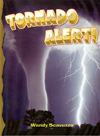 Severe
Storm and Blizzard Alert! is one of sixteen books in the excellent
Disaster Alert! series from Crabtree Publishing. All are recommended
for reading level Grade 4 and interest level from Grades 3 to 9. In
view of recent hurricanes in the US, these books may provide some answers
to lingering questions.
Severe
Storm and Blizzard Alert! is one of sixteen books in the excellent
Disaster Alert! series from Crabtree Publishing. All are recommended
for reading level Grade 4 and interest level from Grades 3 to 9. In
view of recent hurricanes in the US, these books may provide some answers
to lingering questions.
The books are divided into sections that directly correspond to expectations in Ontario's Science and Technology, Grades 1-8. They clearly explain different types of storms and how they are formed, technology used for storm tracking, storm safety and after-effects.
The books are colourful and attractive, including numerous photographs, illustrations and labelled diagrams. Although the author provides both fictional (myths) and factual examples of storms from around the world, the main focus is North America. Imperial measures are used to reference temperature, mass and speed throughout the book, with metric conversions noted in brackets. A glossary covers terminology.
This series would make a good addition to Junior to Intermediate classrooms and libraries. Each book provides students with fun reading – including a "recipe for disaster" section, describing how easily obtained materials can be used to conduct an experiment that simulates a disaster described in the book. In Severe Storm, the experiment simulates lightning.
![]() Disaster
Alert! series (16 titles), Crabtree Publishing Company, St. Catharines,
2004, softcover, each 32 pages, $9.86, tel 905-682-5221 or 1-800-387-7650,
fax 1-800-355-7166, www.crabtree-pub.com.
Disaster
Alert! series (16 titles), Crabtree Publishing Company, St. Catharines,
2004, softcover, each 32 pages, $9.86, tel 905-682-5221 or 1-800-387-7650,
fax 1-800-355-7166, www.crabtree-pub.com.
Reviewed by Maura Ross, currently on leave from her position as an Intermediate teacher at the Simcoe County District School Board, completing her PhD in the curriculum department at OISE/UT.
Guided Reading Basics
Organizing, Managing and Implementing a Balanced Language Program in K-3
by Lori Jamison Rog
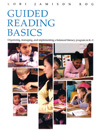 This
easy-to-read guide helps teachers of kindergarten to Grade 3 implement
successful guided reading into their literacy programs. Right from the
book's start there are helpful tips in the margins and practical hands-on
activities.
This
easy-to-read guide helps teachers of kindergarten to Grade 3 implement
successful guided reading into their literacy programs. Right from the
book's start there are helpful tips in the margins and practical hands-on
activities.
I personally like the Five Finger Rule to help students find an independent reading book: If there are five words on a single page that you don't know, then the book is probably too challenging. There are also suggestions for smoother Reading Buddies sessions.
As a kindergarten teacher I found the blackline masters, such as the Independent Reading Record, a little intimidating but adaptable.
This book has a home in my classroom. It has helpful strategies for classroom use, tips for keeping literacy centres organized and advice on how to choose materials. Reading it, I felt inspired and validated in what I was doing and realized that I need some time to reorganize!
![]() Guided Reading
Basics, Pembroke Publishers, Markham, 2003, ISBN 1-55138-160-5,
160 pages, softcover, $21.95, tel 905-477-0650 or 1-800-997-9807, fax
905-477-3691 or 1-800-339-5568, www.pembrokepublishers.com.
Guided Reading
Basics, Pembroke Publishers, Markham, 2003, ISBN 1-55138-160-5,
160 pages, softcover, $21.95, tel 905-477-0650 or 1-800-997-9807, fax
905-477-3691 or 1-800-339-5568, www.pembrokepublishers.com.
Reviewed by Margaret Buckworth, who teaches a Junior/Senior Kindergarten split and Japanese to a kindergarten/Grade 1 split, both with York Regional District School Board.
L'Apprenti Sage
Apprendre à lire et à orthographier
by Brigitte Stanké, (in French only)
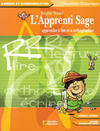 If
you are looking for ideas to vary your teaching and to improve students'
spelling, visual memory and pronunciation, you will find L'Apprenti
Sage a useful resource.
If
you are looking for ideas to vary your teaching and to improve students'
spelling, visual memory and pronunciation, you will find L'Apprenti
Sage a useful resource.
Primary teachers know that some children have trouble learning both simple and complex sounds (phonemes/graphemes) because a French phoneme can be represented by several graphemes, such as in, ain, aim, ein.
I like this book's theoretical foundation and its glossary, which includes the latest speech therapy and cognitive neuropsychology research. Some knowledge of these theoretical foundations is useful.
Seventeen interesting activities – for individuals, groups and remedial training – are included. Objectives, materials, target use, prerequisites and structure are clearly identified for each activity. Materials are reproducible, easy to use and applicable from kindergarten to Grade 2 (or even Grade 3).
Unfortunately, the CD-ROM does not come into play until the tenth activity, when children read a story and learn the magic of words and images. The story can be printed and used as a teaching tool and textbook.
More replicable activities would have been helpful. As a teacher, I like to adapt content to better meet my students' needs. But I draw inspiration from this resource and recommend it to my Primary teaching colleagues.
![]() L'Apprenti
Sage, Chenelière Éducation, Montréal, 2006,
ISBN 2-7650-0280-5, softcover, 126 pages, $42.95, tel 514-273-1066,
fax 514-276-0324 or 1-800-814-0324, info@cheneliere-education.ca, www.cheneliere-education.ca.
L'Apprenti
Sage, Chenelière Éducation, Montréal, 2006,
ISBN 2-7650-0280-5, softcover, 126 pages, $42.95, tel 514-273-1066,
fax 514-276-0324 or 1-800-814-0324, info@cheneliere-education.ca, www.cheneliere-education.ca.
Reviewed by Monia Gaudreault, a Grade 1 teacher at l'École elementaire publique Carrefour-Jeunesse in Rockland in the Conseil des écoles publiques de l'Est de l'Ontario.
New from familiar series
 We
Can Move the World (CD)
We
Can Move the World (CD)
by Joe Crone
Joe Crone's second CD focuses on unity in elementary classrooms. (Geometry Park was reviewed September 2003.)
![]() We Can Move
the World, CD, US$15.00, www.joecrone.com.
We Can Move
the World, CD, US$15.00, www.joecrone.com.
 Professor
Noggin's Card Games
Professor
Noggin's Card Games
Outset Media
New topics in the series include history and geography of Canada.
![]() Professor Noggin's
Educational Card Games, Outset Media, Victoria, BC, 2002-05, each
$14.99, tel 250-592-7374, fax 250-592-7522, www.outsetmedia.com.
Professor Noggin's
Educational Card Games, Outset Media, Victoria, BC, 2002-05, each
$14.99, tel 250-592-7374, fax 250-592-7522, www.outsetmedia.com.
Into the Volcano
A Volcano Researcher at Work
by Donna O'Meara
A day in the life of volcano expert and photographer Donna O'Meara, this is aimed at ages eight to 12 but will be popular with all ages.
![]() Kids Can
Press, Toronto, 2004, ISBN 1-55337-128-3, softcover, 144 pages, $19.95,
tel 416-925-5437, www.kidscanpress.com, webmaster@kidscan.com.
Kids Can
Press, Toronto, 2004, ISBN 1-55337-128-3, softcover, 144 pages, $19.95,
tel 416-925-5437, www.kidscanpress.com, webmaster@kidscan.com.
Extraordinary Women Explorers
by Frances Rooney
Extraordinary Women Explorers is the sixth in the popular Women's Hall of Fame series.
![]() Second
Story Press, Toronto, 2005, ISBN 1-896764-98-3, softcover, 110 pages,
$10.95, distributed by University of Toronto Press, tel 416-667-7791
or 1-800-565-9523, utp@utoronto.caps.
Second
Story Press, Toronto, 2005, ISBN 1-896764-98-3, softcover, 110 pages,
$10.95, distributed by University of Toronto Press, tel 416-667-7791
or 1-800-565-9523, utp@utoronto.caps.









